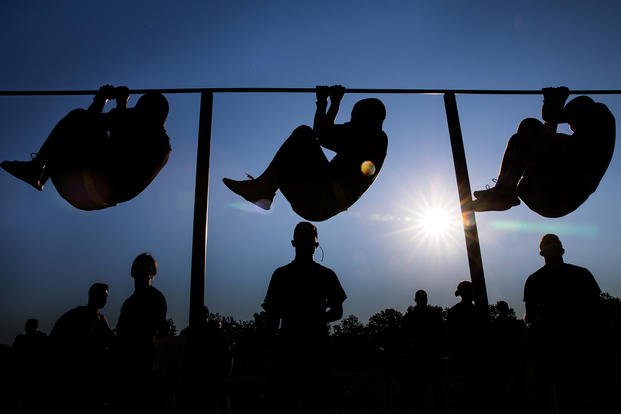With the new fitness test changes in 2020, we’ve come up with a fun workout that we’ve tried out a few times with both Army and Navy/Marine Corps members in the group so that everyone could practice the new testing elements of the Navy physical fitness assessment, USMC physical fitness test and the Army combat fitness test.
Not only does this Joint Workout Challenge do that, but it also provides a fun competition between groups. Both groups earned a healthy respect for each other’s test requirements, too, with the following set-up:
Army leg tuck (aka hanging knee-ups): As you may or may not know, the Army has removed sit-ups from the physical testing process this year. Sit-ups still will be used with the recruiter, basic training PT and in the special ops selections, so you should practice them until all tests in the Army have stopped doing them. The new leg tuck requires a strong grip to hang on the bar, the ability to perform at least half a pull-up to bend the arms and the full effort of your core to get the knees to touch the elbows.
The Navy/USMC plank pose: Nothing new here about this ancient exercise used in yoga for centuries, but it has replaced the curl-ups of both services.
Here is a workout challenge that implements both exercises and builds a fully balanced core muscular system:
Leg tuck/hang challenge: Do as many leg tucks as you can, but track your time hanging from the bar. If you can no longer pull your legs up to your knees, stop that movement but continue to hang from the bar until your grip fails. What is your total time? You have to accumulate five total minutes of leg tucks and hanging during this workout challenge.
Rest with plank pose (2x): The next part of the workout challenge is the plank pose. You have to “rest” in the plank pose for twice as long as you did hanging from the bar (time doing leg tucks and just hanging).
The end of the workout will accumulate a total of five minutes of hanging (x amount of leg tucks) and 10 minutes of plank pose. You will have to build up to this time and level of grip and core endurance, but do the best you can. If you do this once a week, you will see vast improvement in your grip and core strength. After only 2-3 weeks, most of our group have improved by 25%-40% hang time and reps. The plank pose got easier, too.
For example, many of our sets went like this:
Set 1: 1:10 hang (10 leg tucks), 2:20 plank pose
Set 2: 1:00 hang (10 leg tucks), 2:00 plank pose
Set 3: 0:55 hang (8 leg tucks), 1:50 plank pose
Set 4: 0:55 hang (4 leg tucks), 1:50 plank pose
Set 5: 0:45 hang (0 leg tucks), 1:30 plank pose
Set 6: 0:15 hang (1 leg tuck), 0:30 plank pose
Total 5 min hang (33 leg tucks) and 10 minutes plank pose.
As a Navy veteran, I have to say the plank pose has nothing on the new Army leg tuck. That tuck is definitely a much harder exercise, but it’s easy to see improvements in both if you practice them regularly.
Stew Smith is a former Navy SEAL and fitness author certified as a Strength and Conditioning Specialist (CSCS) with the National Strength and Conditioning Association. Visit his Fitness eBook store if you’re looking to start a workout program to create a healthy lifestyle. Send your fitness questions to stew@stewsmith.com.
Want to Learn More About Military Life?
Whether you're thinking of joining the military, looking for fitness and basic training tips, or keeping up with military life and benefits, Military.com has you covered. Subscribe to Military.com to have military news, updates and resources delivered directly to your inbox.
















